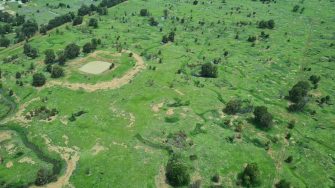
Date: Wednesday, November 24, 2021
Project: Eastern Australian Waterbird Survey
Observers: Richard Kingsford & John Porter
Pilot: Tim Dugan
We left Birdsville under cloudy skies on sunrise. We had a big day in front of us, as we needed to stay ahead of the big front coming in from the west. This was vindicated with afternoon reports of 30 knot winds and rain in Birdsville. We started the day’s survey on Band 7, southwest of Birdsville on the Diamantina River’s waterholes in South Australia.
Surveying one of about five permanent waterholes on the Diamantina River.
Unlike the day before when we crossed the Diamantina in flood, further upstream, there was no evidence of flooding down here. Also, there wasn't much evidence of any widespread rainfall as we had found to the north on the Georgina River catchment. There were very few waterbirds, probably even fewer than normal, mostly just the odd pelican, large egret and cormorant.
We then headed west, crossing a series of waterholes dry lake beds, which fill from the Diamantina River. Then it was past the massive freshwater lake on the Cooper, Lake Yamma Yamma which was dry onto the waterholes of Cooper Creek. Here we survey about six permanent waterholes.
A waterhole surveyed on the Cooper.
There were a few hardhead, black duck and pelicans. Occasionally the floodplain also needs to be surveyed when the river overbanks. There was evidence of a small flood, with water moving down the small channels, creating a crazy paving effect across parts the floodplain.
Result of the minor flooding on the floodplain of the Cooper.
We continued west, surveying a series of farm dams until we crossed the Bulloo River. There had obviously been a small flow, with the tell-tale sign of brown water in the smaller channels. There were a few spoonbills, grey teal and pelicans in one of its permanent waterholes.
Surveying one of the waterholes on the Bulloo River, north of Quilipie.
Afterwards, it was east to the Paroo River and its various tributary creeks. Here there was also water in the channels, evidence of minor flooding. But all the way we hadn’t seen many waterbirds. Some of the waterholes had a few waterbirds. There were a grey teal, wood duck and black duck on some of the ‘puddles’ of water in the main channels of the waterways. The story was similar on the Warrego River, leading into our refuelling stop at Charleville.
From Charleville, we headed east and there was little evidence of flooding.
Surveying an almost dry swamp, just east of Charleville
Then we flew to Mitchell, surveying lots of small dams along the way, not many of them full despite the evidence of rainfall in the vegetation. Many had a few ducks and the odd pelican.
A dam only about 20% full.
Once we reached the town, we surveyed along the Maranoa River which has a weir in town, with a few egrets and then along downstream.
Surveying the Maranoa River, at the town of Mitchell.
Further east, we reached the town of Roma and there we were surprised at how much flooding there was. The dams were full to overflowing.
Surveying one of the large farm dams.
There were also a string of natural lagoons, most of which were flooded, some more than any time that we could remember in more than three decades. This part of the world was really wet. While they didn’t have many waterbirds, there was a good diversity, including a jabiru.
We surveyed a series of farm dams and creek lines as we went further east. And there were just a few grey teal, wood duck, black duck, pelicans and swans but not many other waterbirds.
In some areas there had been so much rain that the landscape was pockmarked with water.
Once we reach Kingaroy there was the large Gordonbrook Dam which supplies the town with water. It had about fifty swans, cormorants and pelicans and a few ducks. And then on to the Joh Bjelke-Petersen Dam named after a former Queensland premier, just west of Kingaroy. It clearly showed how patchy the rain had been, with really very little sign of much filling since last year.
Surveying the Joh Bjelke-Petersen Dam
Some years there is a significant area of water that we survey on this dam but it was very low and the water just confined to the a tributary coming in. There were a few cormorants, wood ducks and black duck but few other waterbirds.
We had hoped that after refueling at Dalby, we could finish off parts of survey band 5 from Narrabri to Armidale and some remaining areas on survey band 4, near Singleton. Unfortunately, the weather beat us. By the time we got down to Split Rock Dam on the Namoi River catchment, it was covered in low cloud and there was no way that we were surveying in the hills. A finish today was not going to happen. We eventually landed in Bankstown after about 10 hours flying. It had been a long day but we had successfully managed to finish the whole of band 7 in Queensland in the day which was really important and ahead of most of the wet weather. We would still need one more day to get it done – when the weather let us.
By Richard Kingsford
